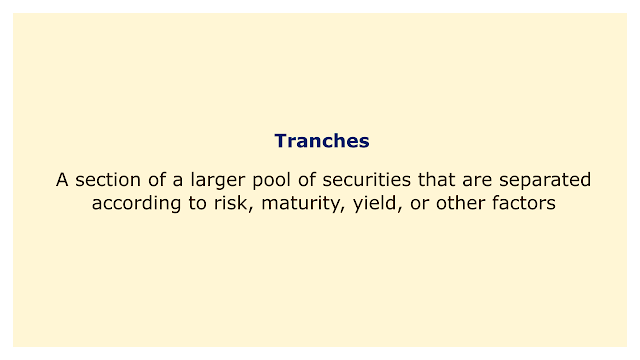 |
| Image: Moneybestpal.com |
A tranche is a French word meaning "slice" or "portion". In the world of finance, it alludes to a section of a larger pool of securities that are separated according to risk, maturity, yield, or other factors. There are specific terms and conditions for each tranche that appeal to various investors.
Consider, for illustration, a group of 100 mortgages that are bundled and offered as a mortgage-backed product (MBS). Based on the interest rates, credit ratings, and order of mortgage payments, this MBS may be divided into different tranches. Depending on their expected returns and tolerance for risk, investors can decide which tranche they want to purchase.
Purpose of Tranches
The major goal of generating tranches is to increase the marketability and variety of debt securities. Issuers can serve various investor groups with various preferences and risk profiles by breaking up a sizable pool of securities into smaller pieces.For instance, some investors might favor tranches with lesser returns but lower risk that have higher credit ratings and seniority in the event of default. Others may choose tranches with higher risk but better returns, but lower credit ratings and subordination in the event of default.
By increasing demand for their securities, tranches can enable issuers to lower their borrowing costs. Issuers can more effectively match the supply and demand curves for their debt instruments by offering various tranches with varied yields.
Examples of Tranches
Collateralized debt obligations (CDOs) and collateralized mortgage obligations are two securitized instruments that frequently use liens (CMOs). These products are made up of many kinds of debt instruments, such as bonds, loans, and mortgages, that are gathered together and offered to investors in tranches.A CDO might, for instance, be made up of corporate bonds with various maturities and credit ratings. Many tranches, including senior tranches (AAA-rated), mezzanine tranches (BBB-rated), and equity tranches, can be formed from these bonds (unrated). Default risk, yield, and term vary depending on the tranche.
Another illustration is a CMO, which includes of mortgages for homes with various interest rates and repayment terms. These mortgages can be broken down into many tranches, such as sequential pay tranches (pay principle sequentially), planned amortization class (PAC) tranches (pay principal in accordance with a predetermined schedule), and support tranches (absorb prepayment risk from other tranches). Each tranche has a unique cash flow pattern, prepayment risk, and interest rate risk.
